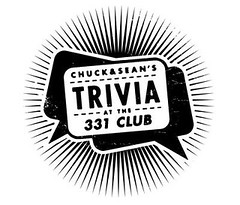at New York's 21.
We didn't drink them dry,
though they may say we tried.
We left so we could drink no more,
to go home and dream from our beds
that when we come back to 21
they don't treat us like the Feds.
 WE'VE BEEN INTERESTED in New York's 21 Club for years, mostly because it piques our fondness for history. After reading Marylin Kaytor's "21" The Life and Times of New York's Favorite Club, we found that the club could have modeled itself after the wildly rambunctious, unbelievably booby-trapped speakeasies of Hollywood talkies. However, Kaytor's anecdotes are of the we-can't-make-this-stuff-up-folks kind, which helped us draw our own conclusion: Hollywood went to 21 for inspiration. Every nook and cranny in this low-light, checkered tablecloth atmosphere has its own fantastic story.
WE'VE BEEN INTERESTED in New York's 21 Club for years, mostly because it piques our fondness for history. After reading Marylin Kaytor's "21" The Life and Times of New York's Favorite Club, we found that the club could have modeled itself after the wildly rambunctious, unbelievably booby-trapped speakeasies of Hollywood talkies. However, Kaytor's anecdotes are of the we-can't-make-this-stuff-up-folks kind, which helped us draw our own conclusion: Hollywood went to 21 for inspiration. Every nook and cranny in this low-light, checkered tablecloth atmosphere has its own fantastic story.Our favorite stories about 21 begin during Prohibition with a man named Soll Roehner, a necessarily trustworthy construction worker, and his equally trustworthy, hand-picked crew. He was put in charge of designing a Federal Agent-proof door, not to keep the Feds out of 21 altogether (21 has never been a private club), just keep them from finding the 2,000 gallons of illegal hooch hidden in the basement. This door would have to endure, successfully, multiple tap tests, draft tests, and any other liquor-seeking tests the Feds could dream up. Roehner had quite a task at hand. He set to work with some ingenious ideas; not only did he design an invisible door, but an undetectable lock as well. Set a few feet back in a small alcove is a wall -- or the door to us insiders. Inside the alcove and on the back wall are thousands of small holes, many of them painted over now. To the Feds these looked like nothing other than places to put pegs on which to rest shelves -- and 21 did just that. They had cured hams hanging above miscellaneous sundries on the shelves. But one of these holes is actually a key hole. If inserted at just the right angle, an 18" long metal rod unlocks the behemoth, 5,000 pound door. Roehner had to design hinges that could facilitate this hulk to move smoothly, so as not to damage the brick on the door and the wall. In Kaytor's book, Roehner speaks about his famous feat of architecture:
"[The door] would have to function with precision balance to avoid damage to the brick door as it met the brick jam stop. A concealed metal adjustment stop was fabricated so that the brick just kissed against brick as the door swung shut. In the locked position, the door had to be perfectly solid with no visible play. The lock had to operate without a conventional key, to be absolutely jam-proof, and to be lockable from the warehouse side in case of siege."
 Inside is a cavern of wines, practically over stuffed with bottles as old as 1880. Bottles of wine seem to be stored in the cellar indefinitely, among them are wines owned by Elizabeth Taylor, Elvis, and Richard Nixon among hundreds of others. Each bottle has the name of its owner labeled on the bottom and facing outward for easy locating. Further back is yet another cavernous room. We had to practically fold ourselves in half to get through this literal hole in the wall. Inside is a luxurious dining room -- longer than it is wide with a table that almost matches the size of the room. This room is also the active red wine cellar, and bottles line the walls. It takes some tricky maneuvering getting out -- especially for those exiting after dining and imbibing. This doorway is jokingly referred to as The Sobriety Test.
Inside is a cavern of wines, practically over stuffed with bottles as old as 1880. Bottles of wine seem to be stored in the cellar indefinitely, among them are wines owned by Elizabeth Taylor, Elvis, and Richard Nixon among hundreds of others. Each bottle has the name of its owner labeled on the bottom and facing outward for easy locating. Further back is yet another cavernous room. We had to practically fold ourselves in half to get through this literal hole in the wall. Inside is a luxurious dining room -- longer than it is wide with a table that almost matches the size of the room. This room is also the active red wine cellar, and bottles line the walls. It takes some tricky maneuvering getting out -- especially for those exiting after dining and imbibing. This doorway is jokingly referred to as The Sobriety Test.It may only be out of sheer unwieldiness that all of this still resides at 21 -- the door in particular -- as many remnants from that dry time have been renovated out of the infamous brownstone at 21 West 52nd Street. "You have to understand," explains Philip W. Pratt, 21's Sommelier. "People did not like Prohibition -- it was not a happy time." So the coat closets with dummy walls that could only open with an electric charge from a strategically placed metal coat hanger are gone, as is the back bar shelf that could turn over and dump bottles of illegal alcohol down a chute leading directly to the New York City sewer system at the push of a button. Kaytor describes what this sight must have been like:
"Shades of Orson Welles, Vienna, and The Third Man -- if one had looked down the opening revealed behind the back bar as the shelves tipped over, one would have seen a brick-lined chute with iron spikes jutting from the walls, arranged so that bottles would strike the spikes and shatter, and then fall on down to an iron grating to smash completely any stubborn glass. Under the grating was an opening leading down past the basement drain and into the New York sewerage system, into which everything ran off to disappear forever!"
For those of you squealing over all of that lost liquor, according to Pratt, the speakeasy was only raided three times. Federal Agents spent many unsuccessful hours searching the place, undoubtedly growing more frustrated by the minute as the smell of alcohol filled the room, and seeing patrons holding only empty coffee mugs instead of splashing cocktail glasses. In one case, an agent thought he had them figured out. This agent asked to be lowered into the water tower on the rooftop, thinking that 21's stash of alcohol would be hidden there. Once he reached the water, however, he remembered that he didn't know how to swim and the search was called off. It was an unsuccessful search with a nearly successful drowning. Another raid was cut short by James J. Walker, New York's Mayor at the time. Of course, it would be devastating to his career to be caught drinking in a speakeasy so "he called his friend the police commissioner," explains Pratt, "and had all the Feds' cars towed." 21 still has Mr. Walker's private booth where he could "do whatever he wanted to do out of the public eye."
The 21 Club's sense of playfulness is not overshadowed by their extreme professionalism. There are lawn jockeys lining the facade of the building and toys hanging from the dining room ceiling -- the toys are an especially surprising sight for such a posh establishment. "This was the second plane that we hung up," Mr. Pratt says as he points upward to a large model plane of the Spruce Goose. "Mr. Hughes had to one-up the first plane we hung up." The first plane, according to Kaytor's book, was an American Airlines plane; 21's website says it was a British Airways "flying boat." Now there are thousands of different memorabilia hanging from the ceiling, from airplanes to baseball bats, brought in by patrons from around the world.
 As for 21s drink selection, they have a talent for making room for new tastes while making sure to keep the classics. We're sure this theory permeates throughout the entire establishment, in fact, and is one of the major reasons for its longevity. We tried The South Side, which is basically a mojito made with vodka instead of rum and, according to Pratt, was invented at 21 along with Humphrey Bogart's drink of choice, the Brandy and Benedictine. We also tried a Cosmopolitan, which, from the first sip, spoiled us rotten for any other Cosmos from any other bar. This Cosmopolitan made all the others we've had in the past seem like something poured out of a juice box rather than the fresh citrus concoction that was set before us at 21. And we couldn't pass up the opportunity to have a martini -- Tanqueray, dry Cezano vermouth, with a dash of orange bitters (yes! They have orange bitters!), straight up with a twist. It was perfect. We tried two of their newer additions to the drink menu, the Peg Leg and the Global Daquiri, which are lemon drinks. We weren't crazy about these new additions to the drink menu, which seemed to be sweet and sour takes on the same recipe, but, admittedly, they were tolerable.
As for 21s drink selection, they have a talent for making room for new tastes while making sure to keep the classics. We're sure this theory permeates throughout the entire establishment, in fact, and is one of the major reasons for its longevity. We tried The South Side, which is basically a mojito made with vodka instead of rum and, according to Pratt, was invented at 21 along with Humphrey Bogart's drink of choice, the Brandy and Benedictine. We also tried a Cosmopolitan, which, from the first sip, spoiled us rotten for any other Cosmos from any other bar. This Cosmopolitan made all the others we've had in the past seem like something poured out of a juice box rather than the fresh citrus concoction that was set before us at 21. And we couldn't pass up the opportunity to have a martini -- Tanqueray, dry Cezano vermouth, with a dash of orange bitters (yes! They have orange bitters!), straight up with a twist. It was perfect. We tried two of their newer additions to the drink menu, the Peg Leg and the Global Daquiri, which are lemon drinks. We weren't crazy about these new additions to the drink menu, which seemed to be sweet and sour takes on the same recipe, but, admittedly, they were tolerable.21 isn't the only remaining speakeasy in New York City; Minetta's, Pete's Tavern, and Chumley's are just a few of the better known establishments that have remained open. 21, however, certainly has the heir of being the most notorious among the group.
We were curious if any of those Federal Agents returned to 21 after Repeal, if only to ask where the good stuff was hidden. Mr. Pratt could only conclude "they probably did." As of now, the Bottle Gang hasn't found any accounts of curious Feds returning to 21 on a friendlier basis. But we agree with Mr. Pratt that at least one agent must have come back. After all, curiosity almost drowned one of them. With a cocktail lounge as luxurious as 21's, we can't see any reason for staying away. Except the danger of drowning in libations more exciting than that found in a water tower.
(MAULT)

 2 oz. whiskey
2 oz. whiskey


No comments:
Post a Comment